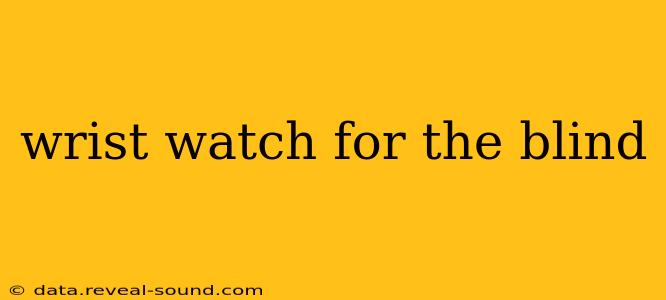For individuals with visual impairments, telling time can present unique challenges. Thankfully, innovative watch designs specifically cater to the needs of the blind and visually impaired community, offering tactile and auditory solutions to access time information. This guide explores the features and functionalities of watches designed for this purpose, answering common questions and providing valuable insights into this specialized market.
What are the Best Features of a Watch for the Blind?
The most crucial features of a wristwatch designed for the blind prioritize tactile feedback and clear auditory cues. These often include:
- Raised Markers: Prominent, raised markers on the watch face enable users to distinguish hours and minutes through touch. These markers are typically bolder and more widely spaced than those on standard watches.
- Tactile Hour Indicators: Some watches utilize different textures or shapes for each hour marker, enhancing the ability to differentiate between them by touch.
- Rotating Bezel: A rotating bezel allows users to track the passage of time, especially useful for monitoring the duration of events or tasks.
- Auditory Time Indication: Many watches include voice output capabilities, clearly announcing the time verbally when a button is pressed.
- Large, Easy-to-Grip Crown: An oversized crown facilitates easy winding and setting of the watch, even with limited dexterity.
- Durable Construction: The watch needs to withstand everyday wear and tear, employing sturdy materials that resist scratches and damage.
What Kinds of Watches are Best for the Blind?
The ideal watch for a visually impaired individual depends on personal preference and needs, but several types stand out:
- Talking Watches: These watches provide clear verbal time announcements, a highly beneficial feature for those with limited or no sight. They eliminate the need for tactile interpretation of the time.
- Braille Watches: Watches with Braille markings on the face allow users to read the time through touch, utilizing the familiar Braille system.
- Simple, Tactile Watches: These watches focus on large, raised hour markers and a simple dial design, making time-telling accessible through touch alone.
How Do Talking Watches for the Blind Work?
Talking watches utilize miniature speakers and sophisticated internal mechanisms. When activated (usually by pressing a button), they process the current time and verbally announce it using a synthesized voice. The clarity and naturalness of the voice vary between models.
Are Smartwatches Suitable for Visually Impaired People?
While many smartwatches offer accessibility features, their effectiveness for the blind can be limited. The small screen size and reliance on visual cues can present challenges. However, some models, with robust voice control and haptic feedback features, may prove beneficial. It's crucial to check the specific accessibility features before purchase.
What Materials are Used in Watches for the Blind?
Durable materials are paramount. Common materials include:
- Stainless Steel: Provides durability and resistance to scratches.
- Titanium: Known for its lightweight yet robust nature.
- High-Impact Plastics: Offer a more affordable yet reasonably durable alternative.
Where Can I Find Wrist Watches Designed for the Blind?
Several online retailers and specialty stores cater to assistive technology, including watches for the blind. It is advisable to thoroughly research and compare various models to find the best fit for individual needs and preferences.
What is the Price Range of Watches for the Blind?
The price range for watches designed for the blind can vary considerably, depending on features and brand. Expect prices to range from budget-friendly models to higher-end options with advanced functionalities.
This guide provides a comprehensive overview of wristwatches designed for the blind. Remember that the best choice depends on individual needs and preferences, and thorough research is key to finding a reliable and suitable time-telling solution.
